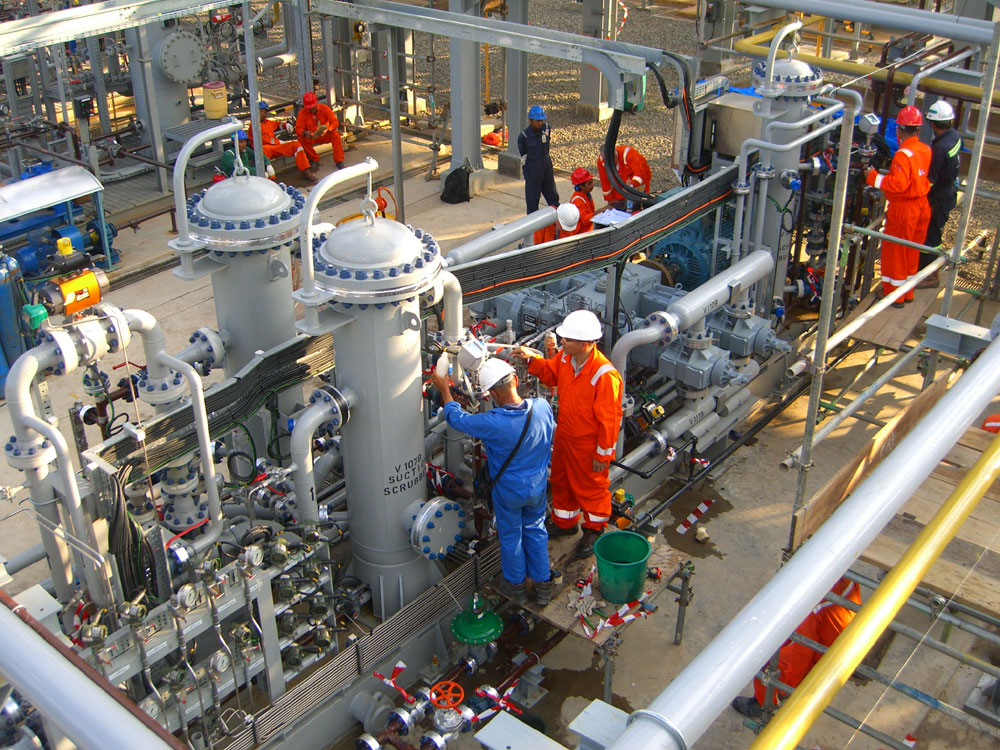A compressor is a device that converts electrical or fuel power into potential energy stored in pressurized gas. Positive displacement compressors are the ones in which a gas is forced into a chamber and the volume of the chamber is decreased to compress the gas.

A positive displacement compressor is divided into the following two types:
1. Reciprocating type: The reciprocating type can be further separated into two sub-types: The more well-known piston style reciprocating compressor, and the less popular reciprocating diaphragm compressor. The piston style compressor uses a rotating crankshaft to allow the gas to be sucked into, compressed, and then expelled from a cylinder. The use of one-way valves makes possible this guiding of the gas in and out of the cylinder.
2. Rotary type: There are many types of rotary compressors the details of each will not be discussed here. There are two shared characterizes between all types of rotary compressors though. The first is the direct transfer of energy from a continuously rotating shaft or shafts into the compressed potential energy of the gas, and secondly is the lack of a need for suction and discharge valves.
Maintenance of compressors
Routine maintenance and monitoring are important to make sure there is no leakage in the compressor and that all parts are moving smoothly. The following inspections should be performed daily on a compressor:
1. Check for gas or oil leaks
2. Check the differential pressure in the compressed air filter
3. Take a look at the oil and decide whether it should be changed
4. Check if the operating temperature is in the safe range
Multi-Stage Compression
Many applications call for a total pressure ratio (discharge pressure/inlet pressure) that is too high to be done in a single cylinder. This limit is primarily due to the elevated temperatures imparted into the gas when it is pressurized. If the pressure ratio is too high then the gas will be heated beyond the temperature limits of the machine.
To circumvent this problem the gas is compressed to an intermediate pressure in one cylinder, cooled down, and then further compressed in a second cylinder. This inter-cooling prevents the gas temperature in the second cylinder from exceeding the machines limits. This process is known as multi-staged compression and the total compression of the gas can be done across any number of stages.
Safety Aspects
Discharge vent: To avoid over-pressurization at the discharge, a discharge vent is provided. This is very important for the safety of the compressor and for preventing any mishap.
Interstage Relief Valve: These are installed at the inter stage separators to relieve the pressure buildup due to valve failure and intercooler fouling.
Packing Gas Vent: This must be provided to avoid contamination of gas with oil in the crankcase.
Insulation: At the suction and discharge pipelines, thermal insulation is provided. Insulation for both, high-temperature discharge and low-temperature intake is provided.
High Suction Temperature Trip: High suction temperature can happen due to problems with intercooler. Very high temperatures can cause damage to the compressor parts. High suction Temperature trip ensures that this doesn’t happen.
High Discharge Temperature Trip: In applications like in the case of polyethylene industry, high discharge temperature can lead to polymerization. If this happens, the flow in the pipe will stop and will rupture the pipe. A high discharge temperature trip is thus necessary.
Low Suction Pressure Trip: It is very important in applications where inflammable gasses such as Hydrogen is needed to be compressed, the low suction temperature can cause atmospheric air to get into the system and when the temperature gets high at the discharge, it can lead to an explosion.
High Discharge Pressure Trip: This device makes sure the discharge pressure doesn’t get higher than the allowable limits. High discharge pressures can lead to damage in pipes and machinery.
Criteria for Selection of A Compressor
- Capacity
- Pressure Ratio
- Size and weight of the compressor
- Power supply characteristics
- Type of Controls
Compressors find many uses in various industries that require storage or transfer of gasses. And the one compressor that is used the most is a reciprocating compressor



